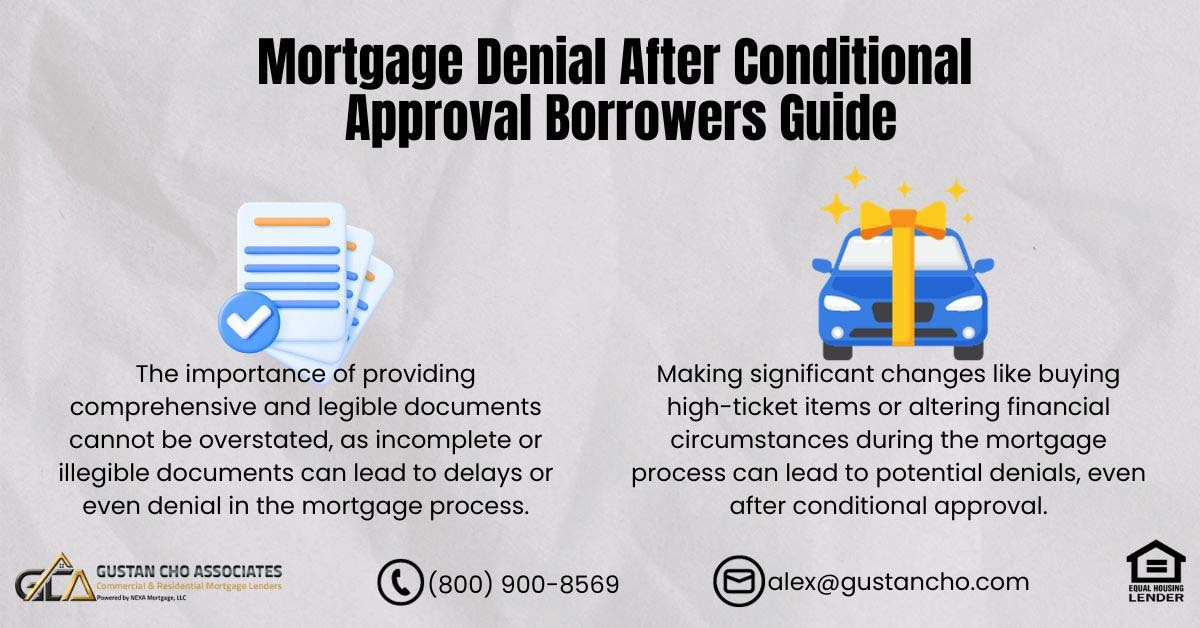In this article, we will address the steps to take if you face mortgage denial following conditional approval. The home loan application and approval involve various stages, and this holds for both home purchase and refinance borrowers. Regardless of the type of borrower, the mortgage application process remains consistent.
Before prospective mortgage applicants sign any documents, the loan officer will require them to fill out a 4-page application, commonly known as 1003.
Subsequently, the loan officer will conduct a credit check, examining credit scores and credit reports. Following this, the application and credit report will undergo evaluation by the Automated Underwriting System for automated approval. In the following paragraphs, we will cover the steps to take if you face mortgage loan denial following conditional approval.
Mortgage Denial After Conditional Approval Borrowers Guide
With an automated approval renders an automated approval after analyzing the following documents:
- two years of tax returns
- two years W-2s
- recent paycheck stubs
- 60 days bank statements
- other documentations
- With AUS approval, the file will be submitted to the processing department of the lender and a processor assigned
Denied After Conditional Approval? We Can Help!
Contact us today to find out how we can help you address the issues and get back on track for approval.
The Importance of Complete and Legible Documents To Avoid Delays in the Mortgage Process
Ensuring the mortgage underwriter receives all required documents in a legible and complete form is crucial for delaying the mortgage loan closing date or obtaining loan approval. The mortgage processor meticulously checks each document to ensure there are no missing pages. Subsequently, the entire file is submitted to the underwriting department, where a designated mortgage underwriter takes charge of the assigned file.
Underwriting Process
A loan underwriter will be assigned to your mortgage file. The role of the underwriter is to make sure the loan applicant meets all guidelines and has the ability to repay the monthly payments of the loan. The role of the underwriter is to review the borrower’s financials:
- tax returns
- W-2s
- employment history
- prior bad credit
- prior bankruptcies
- prior foreclosures
- prior deed in lieu of foreclosure
- prior short sales
- prior late payments
- recent credit inquiries
- bank statements
- reserves
- assets
- liabilities
- other documents that pertain to borrowers
The Role of the Mortgage Underwriter
Underwriters will also review other documents that may be applicable as the following:
- divorce decrees
- child support paperwork
- alimony paperwork
- any other documents
Once the underwriter feels comfortable borrower meets all minimum lending guidelines, the underwriter will issue a conditional approval.
What Is Conditional Approval?
Conditional approval is like getting a “yes” with some requirements. The underwriter says you’re approved for the loan but must meet certain conditions first. Once you clear those conditions, your approval becomes a loan commitment—think of it as a reservation at a restaurant. You have a spot, but you must confirm your party size and menu choices. After you sign the commitment and complete any final steps, the processor will move forward to finalize everything, like getting the final table setting ready before you dine.
Clear To Close By the Mortgage Underwriter
A clear-to-close status is granted when the underwriter has approved all the final conditions on the loan. Upon issuance of the clear-to-close, the file is deemed ready for funding, and the closing department proceeds to prepare the necessary documents. Collaborating closely with the title company, the closing department ensures the final Closing Disclosure is accurately prepared.
The Closing Disclosure Prior to Closing
It can be surprising to find out that your mortgage might be denied even after reaching the final stages of approval. This situation can feel like planning a wonderful trip only to discover that your ticket was never really confirmed. The uncertainty and disappointment can understandably cause confusion and fear.
Mortgage Denial After Conditional Approval
As mentioned above, just because you get conditional approval does not mean that you are guaranteed to close on your home loan. After borrowers are issued a conditional approval, they need to provide the conditions underwriter requests. Examples of conditions may be the following:
- verification of rent
- verification of employment
- updated bank statements
- letters of explanations
- conditions on appraisals
- title
- gift letters
Or more documents that are needed such as the following:
- bankruptcy papers
- divorce decree
- foreclosure verification on recorded dates
- and other items
Denied After Conditional Approval? Explore Your Options
Reach out now to discuss how we can help you move forward with your mortgage application.
Mortgage Denial After Conditional Approval: Buying High Ticket Items During Mortgage Process
One major factor contributing to mortgage denial after conditional approval by the underwriter is the borrower’s use of credit to purchase expensive items. While buying a home is undoubtedly thrilling, with many homebuyers eager to adorn their new residences with fresh furnishings, it is crucial to refrain from applying for credit during the mortgage process. Additionally, not utilizing funds from your bank account designated as verified assets for the down payment and closing costs associated with your home purchase is essential.
Dangers in Buying High Ticket Items During The Mortgage Process
A lot of furniture and appliance stores offer deals like zero interest and no payments for a year when you buy something from them. But this can complicate things when you’re applying for a mortgage. The mortgage underwriter will check your credit at different points during the approval process. Right before giving final approval, they’ll do a soft credit pull.
Any credit inquiries appear on your report, and the underwriter will want to know what those inquiries were about, how they turned out, how much debt you took on, and what your monthly payments look like.
Case Scenario of Mortgage Denial After Conditional Approval
Mortgage denial may arise when the underwriter reviews the credit before issuing a clear-to-close. Any credit inquiries detected by the underwriter serve as a red flag, prompting inquiries about the nature of the inquiry.
The underwriter will seek clarification on whether the borrower has acquired new credit. Should it be revealed that the borrower has made a significant purchase, this could pose challenges for those with higher debt-to-income ratios.
The recent high-value purchase can potentially disrupt the maximum allowable debt-to-income ratio. If the borrower’s debt-to-income ratio exceeds the prescribed cap, the underwriter may return the file to the mortgage processor and loan officer, suspending it. The file remains in suspense until the debt-to-income ratios align with the permitted maximum.
Reasons For Mortgage Denial After Conditional Approval
Additional instances of mortgage denial after conditional approval include situations where the underwriter conducts a verbal verification of employment and discovers that the borrower has recently resigned from their position.
In such cases, the borrower must wait 30 days in their new job and submit 30 days’ worth of paycheck stubs before the mortgage underwriter can grant a clear-to-close status.
If the borrower has switched jobs and the underwriter needs to verify rent, a challenge may arise if the borrower cannot furnish 12 months of canceled checks. This issue is particularly problematic when certain months involve cash payments, rendering the rental verification null and void. All the aforementioned scenarios can serve as grounds for denying a mortgage even after conditional approval.
Qualifying For a Mortgage With a Lender With No Overlays
Over 80% of our borrowers at Gustan Cho Associates are folks who either could not qualify at other lenders due to their lender overlays or due to a last-minute mortgage loan denial. Gustan Cho Associates has no lender overlays on government or conventional loans. If you need to qualify for a home mortgage with a lender with no lender overlays on government and/or conventional loans, please contact us at Gustan Cho Associates at 800-900-8569 or text us for a faster response. Or email us at alex@gustancho.com. The team at Gustan Cho Associates is available 7 days a week, on evenings, weekends, and holidays.
Options If The Underwriter Issued a Mortgage Denial After Conditional Approval
After obtaining a preapproval letter or conditional mortgage approval, can your lender reject your loan application? While it’s uncommon, it can happen. During the loan process, changes in borrower profiles, such as credit scores, employment status, and assets, can affect approval. Additionally, program guidelines may undergo alterations, and underwriters might make errors. It is advisable to adhere to some straightforward guidelines to prevent the risk of mortgage denial after conditional approval.
Prequalification is NOT a Conditional Approval
Many lenders and real estate agents use the terms mortgage prequalification and mortgage preapproval as if they mean the same thing. However, they are actually different.
When you get a mortgage prequalification, the lender has asked about your income, down payment, other assets, and credit. Based on what you tell them, they’ll give you a prequalification letter that suggests you “should” qualify for a loan. Just keep in mind that this info hasn’t been verified yet.
Sloppy Pre-Approval Is Main Reason For Mortgage Denial After Conditional Approval

Related: What Is a Conditional Mortgage Approval?
Automated Underwriting Systems (AUS)
When you apply for a mortgage preapproval, your loan officer uses an Automated Underwriting System (AUS) tool to decide if you qualify for a loan. Think of AUS as a smart assistant who quickly checks your credit report and financial details to give a thumbs up or down. Fannie Mae’s Desktop Underwriter (DU) and Freddie Mac’s Loan Prospector (LP) are two main players in this area. They work fast and help lenders determine if you’re approved for a loan.
Now, let’s compare AUS to manual underwriting with a metaphor. Imagine you’re applying for a job. Using AUS is like having a super-efficient hiring robot that can scan resumes and quickly decide who fits the job description based on specific criteria. It’s fast and takes less time, but you might miss some personal details about the candidate.
In contrast, manual underwriting is like hiring managers taking the time to read each resume thoroughly. They can consider nuances, like special skills or experiences, that don’t fit neatly into a template. While this process is slower, it often leads to a more personal and tailored decision.
So, AUS is quick and efficient, while manual underwriting takes a more human approach, considering the whole picture.
Denied After Conditional Approval? We’ll Help You Get Back on Track
Get in touch today to discuss how we can help you resolve the issues and get your loan back on track.
Conditions from the Automated Underwriting System
Upon receiving an approval or eligible decision, you will also receive a checklist of necessary items to finalize your loan. These may include pay stubs indicating ample income, bank statements, or a home appraisal supporting the agreed-upon home sales price. Closing should proceed smoothly as long as your submitted documents align with the information in your application. If your status is marked as “Refer,” it indicates that your file requires manual underwriting. This could be due to being on the borderline of risk, insufficient information for an automated decision, or invalid or inadequate information on your credit report.
What Does the Automated Findings with Refer with Caution Mean?
“Refer with caution” indicates that, considering the details provided in your application and credit report, you do not meet the criteria for financing approval. If there are inaccuracies, a human underwriter may potentially approve your loan. However, in most instances, a “refer with caution” implies that the software has rejected your application. On rare occasions, you may receive an “out of scope” decision, indicating that the automated underwriting system (AUS) cannot evaluate the product, mortgage, or borrower. In certain situations, manual underwriting might be an option for qualification.
When an AUS Approval Is Not a Real Approval
In mortgage lending, “overlays” refer to additional requirements that lenders impose on top of the criteria established by government programs like FHA, VA, or conventional loans. Essentially, while these programs set minimum standards for credit scores, debt-to-income ratios, and other factors, lenders can implement stricter guidelines.
For example, the FHA lets borrowers with credit scores as low as 580 get a loan with just a 3.5% down payment. But, one lender might have their own rule saying you need a credit score of at least 620, so they’d turn down someone with a 580, even though they meet the FHA guidelines. Conversely, another lender might be okay with that 580 score and approve the loan. These different requirements can lead to different approval results for similar applicants from one lender to another.
Automated Findings of Approve/Eligible per the Automated Underwriting System (AUS)
An AUS approval doesn’t hold unless the documents align with the details in your loan application. Approval isn’t established if you claim an income of $5,000 monthly, but your paystubs reflect $4,000. Likewise, approval isn’t confirmed if the software requests a bank statement indicating your down payment from savings and you fail to furnish it. At Gustan Cho Associates, there aren’t any additional requirements. Generally, an AUS approval is genuine, provided you meet the underwriting criteria and no alterations occur in your file.
What Is a Conditional Loan Approval?
Conditional loan approval means your lender expects to close your loan once you meet all the conditions listed on your approval letter. Mortgage loan conditions can include:
- Updated bank statements: Lenders require recent bank statements to verify that you have sufficient funds for your down payment, closing costs, and reserves. These statements help ensure that your financial situation has remained the same since your initial application.
- Letter of explanation: This letter provides context for any irregularities in your financial history or employment, such as gaps in employment or large deposits. It helps underwriters understand your circumstances better.
- Verification of rent, employment, or down payment: This entails providing proof of your regular rent payments, employment status, or the source of your down payment funds. It assures the lender of your income stability and payment habits.
- Divorce decree: If applicable, a divorce decree is needed to verify any financial obligations resulting from the divorce, such as alimony or child support, which could impact your debt-to-income ratio.
- Bankruptcy filing: If you’ve filed for bankruptcy in the past, the lender may require documentation related to the bankruptcy. This helps assess your creditworthiness and how long ago the bankruptcy was filed.
- Self-employment documents: If you are self-employed, lenders might ask you for documents like tax returns and profit and loss statements to check whether your income is stable and meets their requirements.
- Satisfactory home appraisal: An appraisal determines a property’s worth. This helps ensure that the value equals or exceeds the loan amount. A good appraisal is important to confirm that your investment is worthwhile.
A conditional loan is a real approval if you submit the required conditions and the underwriter signs off. Once your conditions are accepted, the underwriter can issue a clear to close. That means the mortgage underwriter certifies that the loan can be funded.
Related: Conditional Mortgage Approval: Clear to Close
Mortgage Denial After Conditional Approval: What Just Happened?
Usually, conditional approval indicates that your loan is on track to close. However, certain circumstances can swiftly nullify your approval, disappearing almost as rapidly as spilled beer in Death Valley. Changes in your income, credit score, debts, down payment, or other critical factors could lead to this. Opting for a different mortgage program also necessitates starting the process anew.
Understanding Mortgage Conditions During the Mortgage Process
A single situation can lead to further inquiries—like when your bank statement reflects a substantial deposit or a series of bounced checks that need clarification. If you can’t furnish the necessary details, the lender might alter or even cancel the loan program. It’s crucial to maintain consistency once you’ve obtained approval. If you’ve committed to using savings for your down payment, refrain from changing course and borrowing instead. Avoid pursuing new credit or raising your debts until after the loan closure. Additionally, ensure timely payment of all bills to safeguard your credit score.
Mortgage Denied After Conditional Approval? It’s Not Too Late!
Contact us today to learn how we can help you address the challenges and move forward with your home loan.
Can I Reapply for a Mortgage if I Get Mortgage Denial After Conditional Approval?
More than 80% of borrowers who found success with Gustan Cho Associates were either unable to meet the criteria with another lender or faced rejection after an initial approval elsewhere. Facing denial for a mortgage isn’t a cause for embarrassment; often, it simply indicates a mismatch between you and the chosen lender. Feel free to consider applying with us—it’s a quick process. At Gustan Cho Associates, we operate without lender overlays and specialize in innovative financing solutions, often assisting individuals struggling to qualify for a mortgage through other channels.
Minimum Credit Score Requirements to Qualify For Mortgage
The minimum credit score to qualify for a 3.5% down payment FHA loan is 580. VA home loans have no minimum credit score requirement or debt-to-income ratio cap. We at Gustan Cho Associates follow standard AUS findings, with zero overlays on FHA, VA, USDA, and conventional loans. To get a fast pre-approval, contact us at Gustan Cho Associates. Start the qualification and pre-approval process by clicking this icon: GET PRE-APPROVED NOW, email us at gcho@gustancho.com, or call us at 800-900-8569. Or Text us for a faster response. Our support and licensed personnel are available 7 days a week, holidays included.
FAQ: Mortgage Denial After Conditional Approval
Q: What is Conditional Approval in the Mortgage Process?
A: Conditional approval is granted by an underwriter once the borrower satisfies all the conditions for the applied loan program. These conditions must be resolved to transform conditional approval into a loan commitment.
Q: What Happens After Conditional Approval?
A: Once all specified conditions are resolved, the processor initiates the submission of the file for a clear to close (CTC). The file is deemed ready for funding upon receiving the clear-to-close status.
What is the Role of the Mortgage Underwriter?
A: The mortgage underwriter reviews the borrower’s financial documents to ensure they meet all guidelines and have the ability to repay the loan. This includes assessing income, credit history, employment status, and other financial factors.
Q: Why Might a Mortgage be Denied After Conditional Approval?
A: There are several reasons why a mortgage might be denied even after conditional approval, including changes in the borrower’s financial situation, failure to meet specified conditions, or discrepancies in documentation.
Q: What Can Lead to Mortgage Denial After Conditional Approval?
A: Factors such as significant purchases on credit, changes in employment status, incomplete documentation, or discrepancies in financial information can all contribute to mortgage denial after conditional approval.
Q: Can I Reapply for a Mortgage if I’m Denied After Conditional Approval?
A: Yes, you can reapply for a mortgage with a different lender. Some borrowers find success with lenders who have fewer or no lender overlays, which are additional requirements imposed by some lenders beyond standard underwriting guidelines.
Q: What are Some Common Mortgage Conditions During the Loan Process?
A: Common mortgage conditions may include providing updated bank statements, letters of explanation for certain financial transactions, verification of rent or employment, divorce decrees, bankruptcy filings, and satisfactory home appraisals.
Q: What is the Importance of Maintaining Financial Consistency After Conditional Approval?
A: Maintaining financial consistency after conditional approval is crucial to avoid any changes that could jeopardize the loan approval. This includes refraining from new credit applications, significant purchases, or changes in financial behavior until after the loan closure.
Q: What are the Minimum Credit Score Requirements to Qualify for Various Loan Programs?
A: Minimum credit score requirements vary depending on the loan program. For example, the minimum credit score for an FHA loan with a 3.5% down payment is 580, while VA loans have no minimum credit score requirement.
Q: How can I Get Pre-Approved for a Mortgage?
A: To get pre-approved for a mortgage, you can start by contacting a lender and completing a mortgage application. Be prepared to provide documentation such as income statements, bank statements, and employment verification.
This blog about Mortgage Denial After Conditional Approval was updated on April 24th, 2025.
Mortgage Denied After Conditional Approval? Let’s Get You Approved!
Contact us now to explore solutions and improve your chances of securing the financing you need.










Hi– I’m just thinking about buying a home but wanted to see what my options are.
The main issue for me is a 5 month employment gap– I’m starting a new job soon (as CEO of a startup company) but it will take a few months for my employment to begin for various reasons, but then I’ll have a steady $150k/year w2 job.
I can easily qualify for conventional financing in 4 months or so once I have 30 days of paystub but am considering buying a house now (if it makes sense). I wanted to see if I qualify for a bridge loan / hard money loan , or even better, for an Offer Letter loan. Depending on the loan, if the interest rate etc is good I’d just keep it, but if it is a hard money high interest loan I’d of course refinance asap (likely 4 months).
I put $360k for loan amount but it might be considerably less than that– we’re looking at a home now that is listed as $290k, but in general, we are in the $350k range or so, to as high as $400k home price range, and want to put down 10% now. We could potentially put down more.
Thanks!